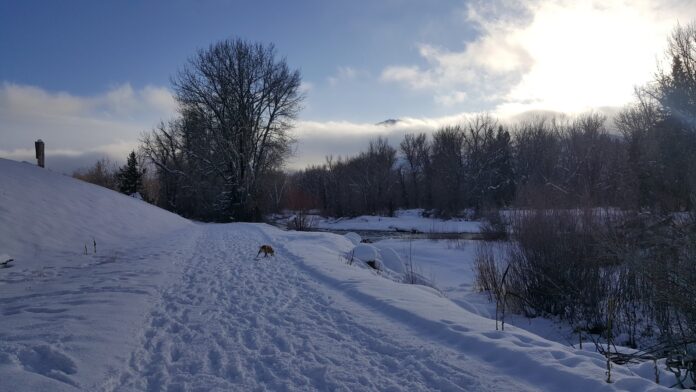BY HARRY WEEKES
In February, I went to a talk at the Sun Valley Museum of Art for their current exhibition, “Snow Show: Winter Now.” The artist, Rob Reynolds, featured his film “The Word for Weather is Knowledge”—a mesmerizing flight through Greenland with a voiceover from a native Greenlander. Here I learned the Inuktitut “word” sila. This is the referenced title word that is translated to ‘weather’ or ‘environment.’
It turns out, the structure of that last sentence is important—“is translated to.” Because sila is less of a word than a concept, what one author referred to as a “super-concept … referencing senses that are intellectual, biological, psychological, environmental, locational, and geographical.”
Rob’s story about learning this concept was direct and blunt. “Yeah, one of the locals watched us drive our boat next to a huge wall of ice. When we got back, he agreed to be our guide. When we asked why, he said, ‘So we don’t do something so stupid again.’” This gets to the wisdom part of the concept.
In a world governed by intense and subtle fluctuations of ice, to know the weather is to survive. Weather is then, of course, wisdom.
It was thinking along these lines that I came to a startling conclusion. “If this is true, I could very well be the dumbest person in the Wood River Valley.”
Despite having lived here for over five decades, my understanding of the weather is childlike, at best. And there is no better time to expose one’s knowledge of the weather than March in the Rocky Mountains.
In the last week, it snowed twice, blew in gusts over 40 miles per hour, snained (snow-rained), was overcast, and temperatures ranged from the single digits to the mid-40s. In other words, it was the standard hodgepodge of late winter-early spring conditions.
My personal weather experiences were as mercurial. On one hike, I left the sheltered valley of my backyard to crest the slope behind our house and thought my Dachshunds were going to blow away in the wind and ice. On another, the family got pelted by snow, decided to turn around before we re-enacted the Donner Party, then watched as the cloud blew past and bluebird skies opened up. During one morning, looking north as the clouds crested and obscured Baldy, someone said, “It’s supposed to start snowing at 10 a.m.” By 2 p.m., the clouds hadn’t made it to Indian Creek.
Ironically, amidst all of this, I could not have more access to atmospheric information; there are seemingly as many weather apps as there are people and everyone talks about the weather as if they are a meteorologist. As in, “Yeah, it’s been an unusually dry January,” or, “It doesn’t really get nice until the 4th of July.”
And the simple truth is this: I have no idea. If I had to stake my next three weeks’ plans on what I can gain from looking outside, where clouds (that may be cumulus) are obscuring the Boulders, where there are some high, thin clouds (perhaps cirrus) over my house, and where today is one of those days where the contrails don’t just linger but expand, I am confident only in that I would be doomed.
Stucco walls, panes of glass, and an HVAC system keep the weather at bay. It turns out, they also do the same for wisdom.
Fortunately, though, I think the solution is simple: open the window, open a door, walk outside, pay attention. The wind, the clouds, the snow and rain—each gust, each cotton-ball clump, each flake or drop—has a little something to teach us. If we just take the time to listen.
Harry Weekes is the founder and head of school at The Sage School in Hailey. This is his 53rd year in the Wood River Valley, where he lives with Hilary and two mini-Dachshunds. The baby members of their flock have now become adults—Georgia and Simon are fledging in North Carolina, and Penelope is fledging in Vermont.



